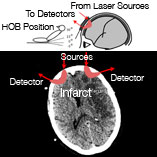Bedside monitoring of brain blood flow in stroke victims is the outcome of research conducted by Prof. Turgut Durduran, who has recently joined ICFO.
A University of Pennsylvania team has completed the first successful demonstration of a non-invasive optical device to monitor cerebral blood flow in patients with acute ischemic stroke, a leading cause of disability and death. Prof. Tugut Durduran, who has recently joined ICFO, is the leading author of the paper reporting the results of a study that was completed when he was still at UPenn. The publication appeared in the March 2nd issue of Optics Express (Durduran et al Opt. Express, 17(5):3884-3902, 2009).
“Our preliminary study demonstrates that blood flow changes can be reliably detected from stroke patients and also suggests that blood flow responses vary significantly from patient to patient,” Prof. Durduran said. The device being developed uses optical probes that are placed over major cortical blood vessels in each hemisphere of the brain. The technology, hybrid diffuse correlation and diffuse optical spectroscopies, is a non-invasive system that uses lasers, photon-counting detectors, radio-frequency electronics, data processors and a computer monitor to display functional information for physicians and nurses.


